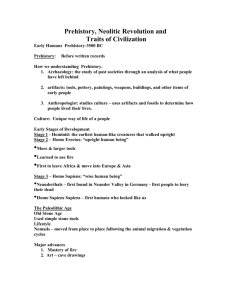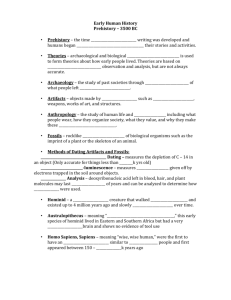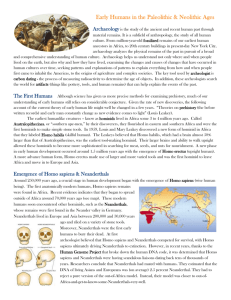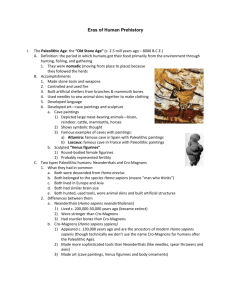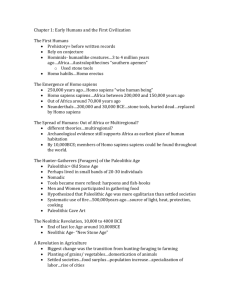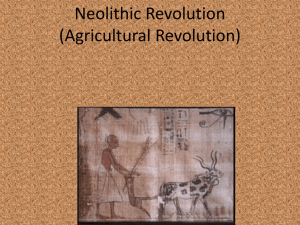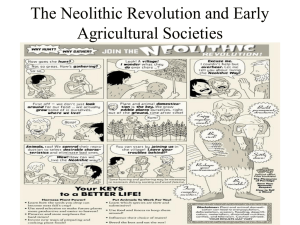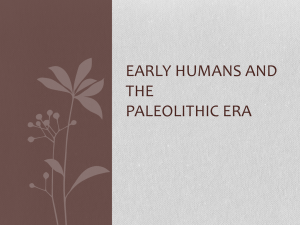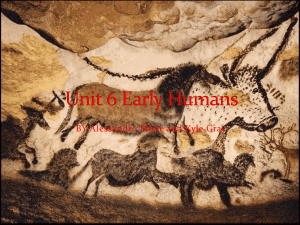1.1-TheFirstHumans
advertisement
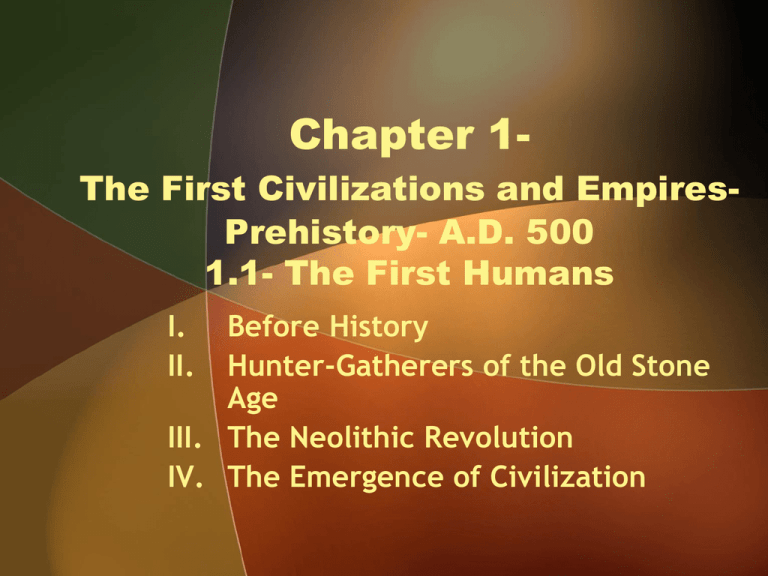
Chapter 1The First Civilizations and EmpiresPrehistory- A.D. 500 1.1- The First Humans I. II. Before History Hunter-Gatherers of the Old Stone Age III. The Neolithic Revolution IV. The Emergence of Civilization Before History • prehistory – the period before history – the period for which we have no written records – circa 2,500,000 Y.A. to 4,000 B.C. Before History • archaeologists and anthropologists – scientifically analyze human remains to study the development of early human beings Before History • hominids- humans and other humanlike creatures that walk upright Before History • australopithecines – earliest human-like beings – lived in Africa 3 to 4 million years ago – they were the first hominids to make stone tools Before History • Homo erectus“upright human being” – the next stage of human development – dates from about 1.5 million years ago – used larger and more varied tools than the first hominids Before History • Homo sapiens “wise human being” – emerged around 250,000 years ago Before History • Two subgroups developed from Homo sapiens: – Neanderthals • lived in Europe and Southwest Asia and died out by 30,000 B.C. – Homo sapiens sapiens • the first group that looked like modern humans • appeared in Africa between 150,000 and 200,000 years ago • could be found throughout the world by 10,000 B.C. • All humans today belong to this subgroup of Homo sapiens The Hunter-Gatherers of the Old Stone Age • A basic distinguishing feature of human beings is their ability to make and use tools – early tools were made of stone – the term Paleolithic Age (“old stone”) refers to the earliest period of human history • The Paleolithic Age lasted from about 2,500,000 to 10,000 B.C The Hunter-Gatherers of the Old Stone Age • Early humans survived by hunting, fishing, and gathering food – eventually learned • to make more sophisticated tools • how to use fire • how to change their physical environment The Hunter-Gatherers of the Old Stone Age • Paleolithic peoples were primarily nomads, people who move from place to place • Even so, they created a human culture that included sophisticated cave paintings The Neolithic Revolution • Human survival depends on the systematic growing and storing of food – an accomplishment of the people of the Neolithic Age – the Neolithic Revolution began after the end of the last Ice Age (c. 8000 B.C.) • lasted from 8000 to 4000 B.C. • a change from the hunting and gathering of food to the keeping of animals and growing of food on a regular basis – an activity known as systematic agriculture The Neolithic Revolution • The planting of crops and the domestication (taming) of animals for food and work provided humans with a regular supply of food – Some historians believe that this was the single most important event in human history • The ability to acquire food regularly gave humans greater control over their environment and made it possible for them to establish more permanent settlements – As people settled into villages or towns, they created buildings for protection and for storage, and they began to trade surplus goods The Neolithic Revolution • Increased wealth led to the creation of armies and walled cities and to more complex societies – By 3000 B.C., large numbers of people lived in the river valleys of Mesopotamia, Egypt, India, and China The Emergence of Civilization • Culture is a people’s way of life. • A civilization is a complex culture in which large numbers of people share many common elements • The six basic characteristics of civilization are: – – – – – – cities government religion social structure writing art The Emergence of Civilization • Increased food production led to growing populations and to the rise of cities – Governments were formed to protect the people and to maintain the food supply – Urban civilizations developed religions to explain the workings of nature and the existence of things – New social structures dominated by rulers and an upper class of priests, government officials, and warriors arose The Emergence of Civilization • Abundant food supplies allowed some individuals to become artisans and craftspeople instead of farmers – They created luxury items for the upper classes – Writing was used to keep records – The arts thrived, and temples and pyramids were built as places for worship, sacrifice, or the burial of kings The Paleolithic Age lasted for close to 2.5 million years, whereas the Neolithic Age lasted for 6,000 years. Neolithic Period Click the mouse button or press the Space Bar to display the answers. Paleolithic Period Checking for Understanding Define Match each definition in the left column with the appropriate term in the right column. __ A 1. humans and other humanlike creatures that walk upright __ D 2. the keeping of animals and the growing of food on a regular basis __ E 3. adaptation for human use __ B 4. a person who moves from place to place __ C 5. the shift from hunting of animals and gathering of food to the keeping of animals and the growing of food on a regular basis that occurred around 8000 B.C. A. hominids B. nomad C. Neolithic Revolution D. systematic agriculture E. domestication Identify Neanderthals • lived between 100,000 and 30,000 B.C. • lived in Europe and SW Asia • might be the first hominids to bury their dead Homo sapiens sapiens • first appeared 150,000 to 200,000 years ago • spread all around the world by 10,000 B.C. • all humans today are part of this subgroup of Homo sapiens Locate Africa Europe Checking for Understanding Contrast the evidence that archaeologists and anthropologists use to understand the past to that used by historians. While historians use written records, archaeologists and anthropologists must analyze human remains to understand the period before written records were kept. Checking for Understanding List the species that emerged during the different stages of human development. first stage: australopithecines second stage: Homo erectus third stage: Homo sapiens with subgroups Neanderthals Homo sapiens sapiens Critical Thinking Analyze Does the development of systematic agriculture by Neolithic peoples after the end of the last Ice Age deserve to be called a revolution? Why was the shift to systematic agriculture important to the development of civilization? Possible answer: A regular food supply allowed humans to give up their nomadic existence and live in settled communities. As communities became more complex, government became necessary. 7. Sequencing Information First Civilizations Mesopotamia Egypt India China Analyzing Visuals Examine the cave painting of a bison shown on page 19 of your textbook. Many cave paintings from the prehistoric period depict similar subjects. What do these paintings tell us about the lifestyles of prehistoric peoples? The paintings tell us that there was an importance of hunting and animals to nomadic societies.
